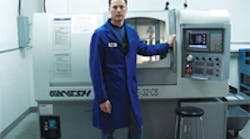Today’s small shops are increasingly discovering the power of seven – that is 7-axis dual-spindle CNC screw-type turning machines.
Such multi axis machines have always been associated with highvolume work, and usually priced out of the reach of the low to medium-volume shops. Because of time-consuming setups, the machines weren’t cost effective for high-mix, low-volume work. But that seems to be changing thanks to factors such as the elimination of guide bushings and other efforts by OEMs to produce affordable multispindle machines.
Jobshops now have the option to produce low volumes of turned and milled parts in single setups from barstock as opposed to making them from raw blocks using multiple machines requiring multiple programs.
Setups are much faster, as are job changeovers, and part accuracies improved. Jobshops can run more jobs with fewer parts in fully automated production, while also reaping the same benefits/profits that shops running high-volume jobs do.
“All of a sudden, small shops can combine operations and run parts unmanned on one machine, making them a lot more competitive and profitable,” Harvinder Singh, president of Ganesh Machinery, said. One feature that speeds setups is the elimination of guide bushings. And Singh said that guide bushings are the main reason that a lot of shops crash multispindle machines. Without guide bushings, the machines are also less complicated and therefore easier to setup and change over.
Singh’s company offers two sliding headstock, 7-axis, dual-spindle CNC multi axis turning center models, the Cyclone 25 CS and Cyclone 32 CS. He said that having only two models contributes, in part, to the company being able to offer the machines at affordable prices.
The machines do not require the use of ground bar stock or guide bushings as conventional Swissstyle machines do. That represents additional cost savings when using the Ganesh machines, Singh said. As many of the machines’ 27 available tools as necessary can be used to rough and finish part features, unlike Swiss machines that are limited by the length of the guide bushing and must micro-feed cuts to make the rough and finish cut with one tool in one pass, he explained.
Two job shops benefiting from 7-axis CNC dual-spindle turning machines are E&R Machine in Van Nuys, Calif., and Promore (www.promore.com), a Core Laboratories company.
“They are high-production machines, but I also use them as jobshop machines to run part volumes of 50 to 100 at a time,” Elco Garcia, president and owner of E&R Machine, said about his three Ganesh machines.
His shop specializes in mostly medical and aerospace parts. Jobs can vary in size from 50 to 20,000 parts. And at the time of this interview he had one of the Ganesh machines set up to run a 400-part job, then switch over to a different 2,000-part job.
Garcia said he simply loads bar stock and writes one program per job and gets completed parts off the Ganesh machines. He also said that he didn’t consider any other type of machine because his parts are relatively small and involve a lot of milling – which in the past, would have required using a separate turning machine, then milling machine, and programs and setups for each of those machines.
At Promore, a Ganesh CS-32 machine runs mostly low-volume jobs. That’s because it’s housed in the shop’s R&D department and used for prototype work.
The shop prototypes mechanical components for the sensor equipment it produces. In the past, this prototype work was farmed out, but many outside shops weren’t interested in doing such short-run work and under the tight delivery requirements Promore needed.
“We weren’t an ideal customer, so we brought the process in-house with the Ganesh. Doing that provided the small quantities we needed quickly and let us maintain access to part programs for evolving them,” Colin Bussiere, manager of engineering at Promore, said.
According to Bussiere, the Ganesh machine has accelerated Promore’s whole development cycle. The shop also runs production on the Ganesh for some of the parts it has prototyped on that machine.
“We are beginning to do larger runs, such as 200 or so pieces, and the machine helps us do that. Its subspindle, in particular, has really been a key feature,” he said.
Bussiere said that having a subspindle on the machine improves the shop’s part accuracy by eliminating the need for multiple part setups, and it gives the machine a level of automation to run the larger batches unattended. The shop is adding a firesuppression system to the machine – it uses straight oil – so that it can run production levels overnight to keep the machine freed up for short-run prototype work during the day.
The shop’s parts are small and made from difficult-to-machine high-end Inconels. The more the shop worked with these materials, the more it realized that its gang-tool-type lathes with pneumatic live tooling didn’t work well with the materials, and the shop wanted to start doing parts that would require a machine with Y-axis capabilities and other features.
“We considered conventional Swissstyle machines, but a big concern was having to deal with guide bushings and how that might slow us down when trying to produce a variety of short-run parts,” Bussiere said.
“We needed a high-precision machine for smaller parts and one that was flexible as far as job changeovers were concerned. The Ganesh machine was the best fit for us,” he added.
No one at Promore had any prior experience with a machine such as the Ganesh. So before deciding to purchase the machine, Bussiere, one of the shop’s mechanical engineers and a technologist that provides engineering support attended a training course at Ganesh’s facility in Chatsworth, Calif.
The training solidified the deal for the shop, Bussiere said. After three days of classroom and hands-on training, the group came home with a prototype part and programmed it.






